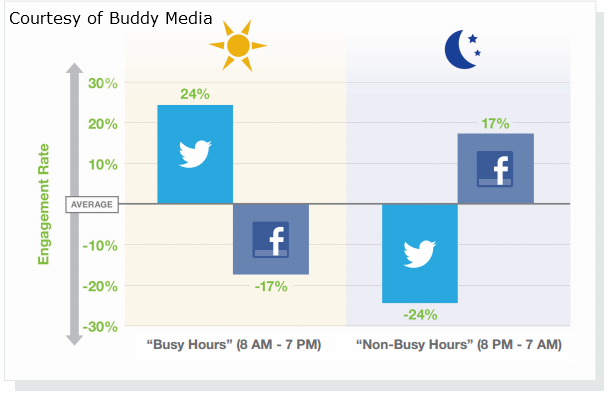A report from Buddy Media detailed the dynamic nature of social media marketing with Twitter and the need for companies to adjust their campaigns depending on behaviors of their target audiences. According to the study, brand engagement increases by 17 percent on the weekends, but just 19 percent of all branded social content is shared on the weekends.
While the best days and times to share social content are going to vary from industry to industry, companies must regularly assess the engagement they see and tailor their campaigns to reach their audiences when they’re most active. According to Buddy Media, the clothing and fashion industry, for example, sees interaction increase on the weekends and in the middle of the week. However, the entertainment industry sees a spike on Sundays into Mondays after a lull on Saturdays.
In terms of the types of content marketers can create to leverage these trends, finding topical tie-ins to industry news can drive interest.
According to the study, brand engagement increases by 17 percent on the weekends, but just 19 percent of all branded social content is shared on the weekends.
It’s important to remember that content marketing‘s goal is to increase site traffic and drive prospects through a conversion funnel. Content writers should keep an eye on trending topics and look for relevant ways to link social or website content to these events. Simply writing an article about a popular topic that is entirely irrelevant to an industry will hurt a company’s reputation on the web, but Buddy Media’s report shows there is demand for industry news.
Content marketers should be sure to keep their profiles updating or automate news from the week to publish on the weekends, as people are more likely to read news content on Saturday than they are on other days. According to the study, news content is accessed 29 percent more often on Saturdays as people take this day to catch up on the latest headlines. However, just 7 percent of Tweets from marketers creating industry news content come on the weekends.
It can be difficult, of course, for companies to keep their social media marketing efforts moving on the weekends. Often, an organization will turn to automation of some kind to tweet content on off hours. This is certainly preferred to just going silent for a few days. However, Brafton recently found that interactive social marketing campaigns drive more traffic and engagement than automated campaigns.
According to our research, clicks per post increased from 10.7 on average for automated efforts to more than 31 clicks on interactive content. Moreover, maintaining a line of communication with prospects throughout the week will keep them interested and drive conversions. Whether it’s a question about a product or service or reaction to content shared on the network, Brafton recently reported that customer service is a key factor in brand loyalty for more than 60 percent of consumers.
In general, monitoring usage trends on different social networks will help inform activity and optimize a marketing campaign for conversion. After all, even the best content marketing effort will fail if content isn’t delivered effectively. According to Buddy Media, other social networks show differing trends in terms of peak activity. During the week, content shared on Facebook between “busy” business hours (8 a.m. to 7 p.m.) receives 17 percent less engagement than content shared between 8 p.m. and 7 a.m. Again, clicks, comments and Likes will vary from business to business and some industries may find results entirely opposite to Buddy Media results, but the idea of generating a reliable profile of a target audience and creating content in line with their social activity schedule is essential.
Brafton recently reported that 68 percent of marketers consider creating relevant content that will reach the right audience their top priority moving forward.



